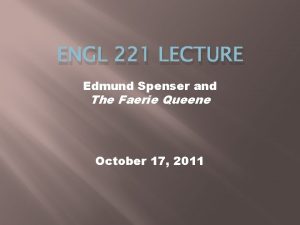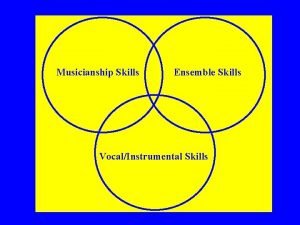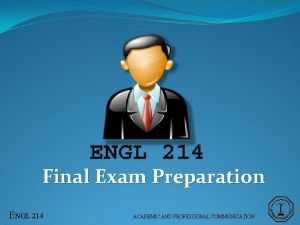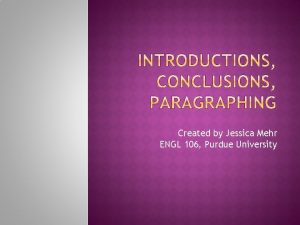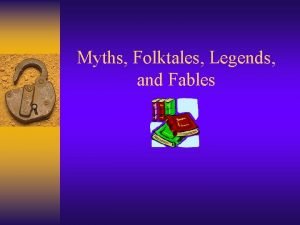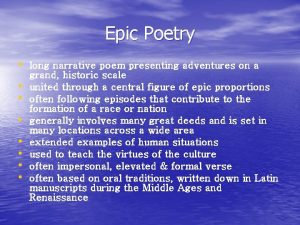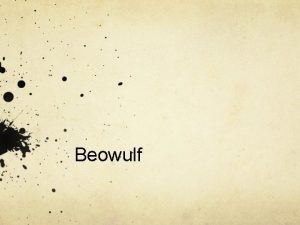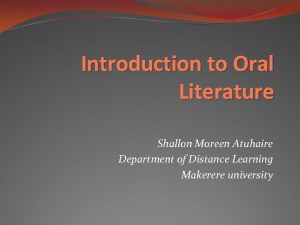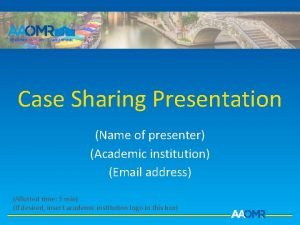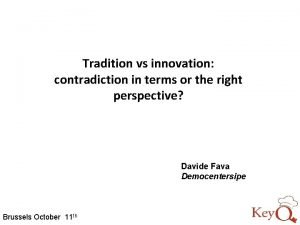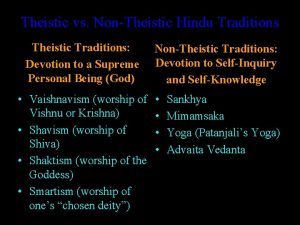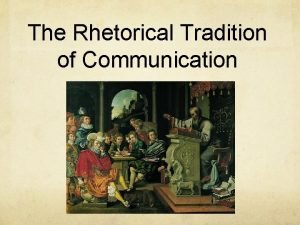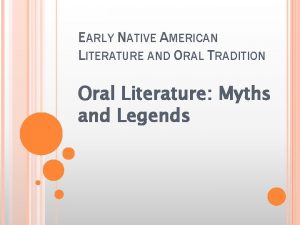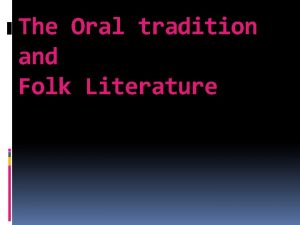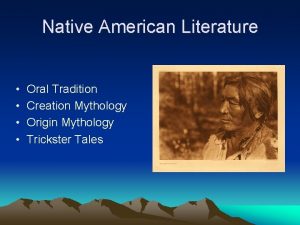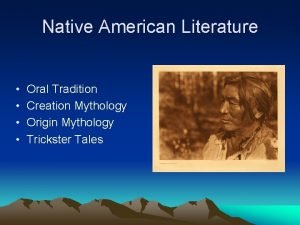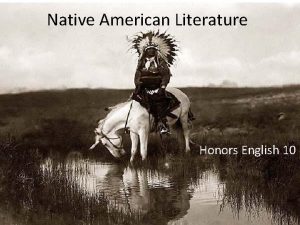Oral Tradition in American Literature ENGL 2130 American
















- Slides: 16

Oral Tradition in American Literature ENGL 2130 American Literature

OBJECTIVES Introduction to Native American Culture and Oral Tradition Competency Area #1 (Literature and Culture) Important Themes in Native American Oral Tradition Competency Area #2 (Essential Themes and Ideas) Stylistic Characteristics of Native American Oral Tradition Competency Area #2 (Essential Themes and Ideas) Reader-Response Approach to Literature Competency Area #4 (Research and Writing)

PURPOSE OF THE ORAL TRADITION Competency Area #1 (Literature and Culture) • Information, memories, and knowledge is communicated orally from one generation to the next • Help preserve language and culture • One of the ways they learned about the world

LITERATURE AND CULTURE Competency Area #1 (Literature and Culture) Early inhabitants of America Belonged to more than 200 distinct groups Relied heavily on oral tradition (no writing) Diverse Groups within the Native American Culture Spoke more than 300 different languages Each group had different customs and beliefs From Oral Stories to Written Record Sequoyah (silversmith) introduced the first writing system (1809)

IMPORTANT THEMES (Living in Harmony with Nature) Competency Area #2 (Themes and Essential Ideas) Different Native American groups, but their stories had similar themes. Some of themes include the following: 1) Living in harmony with the natural world 2) Strong Sense of Community 3) Respect all Forms of Life

IMPORTANT THEMES (Connection to Nature) Competency Area #2 (Themes and Essential Ideas) Humans are connected to nature, plants, animals, the land There is no ownership of land as humans are a part of nature Example: Yellowstone Valley and the Great Flood Native American myth about a flood sent to punish people who were not living in harmony with nature

IMPORTANT THEMES (Community) Competency Area #2 (Essential Themes and Ideas) Strong Sense of Community Importance of establishing good relationships within a group High value is placed on generosity, helpfulness, and respect Example: “The Girl and the Chenoo” Story about a girl who turns an ice monster human by bringing him back into her community.

IMPORTANT THEMES (Respect all forms of life) Competency Area #2 (Essential Themes and Ideas) Respect all Forms of Life Stories reflect their beliefs and way of life Respect animals, plants, ancestors Deep reverence for the land Example “When the animals left Lenape Land” Lenape Indian legend about a clan of giants that taught the people a lesson about respecting animals.

IMPORTANT THEMES (Creation of the World) Competency Area #2 (Essential Themes and Ideas) Creation of the world Describe the creation of the world How the universe, the earth, and life began Example: “The Iroquois Creation Story”

STYLISTIC CHARACTERISTICS Competency Area #2 (Essential Themes and Ideas) Describes the creation of the world How the universe, the earth, and life began Example: “The Iroquois Creation Story”

STYLISTIC CHARACTERISTICS (Performance) Competency Area #2 (Essential Themes and Ideas) Performance Emphasizes Performance and other physical aspects Told by a performer who used inflections and gestures Role of the Performer is highly regarded Tale belongs to community (no single author) Audience participated in the tale They gave feedback to the performance Dynamic or Constant Change Tale changes depending on who is telling it Tale is recreated many times

STYLISTIC CHARACTERISTICS (Literary Devices) Competency Area #2 (Essential Themes and Ideas) Repetition • Key element in oral tradition • Important for ceremonial reasons • Aids in memorization • Creates rhythm and balance Other Literary Devices • Metaphor • Personification • Symbolism

STYLISTIC CHARACTERISTICS (From Oral to Written) Competency Area #2 (Essential Themes and Ideas) Challenges of Written Record • Prone to inaccuracies and distortion • Absence of the performance aspects • Less dynamic • Lack of audience’s feedback to storyteller Benefits of the Written Record • Can ensure preservation • Read as a written text (reader-writer relationship) • Permanent Record • Possibility to reach wider audiences

STYLISTIC CHARACTERISTICS (Major Genres) Competency Area #2 (Essential Themes and Ideas) Trickster Tales • • • Animal with two sides to its personality Character is often a coyote Often used to teach children a lesson Pictographs • Picture stories (like cave drawings) Creation Myths • Explain the beginning of the world Ritual Songs/Chants • Parts of religious ceremonies

Reader Response Approach to Literature Competency Area 4 (Writing and Research) Reader-response stresses the role of the reader The reader explains (and defends) his or her personal reaction to the text Questions to consider: What does the text have to do with you personally? How much does the text agree with or clash with your views? Does the text remind you of something you have seen, read, or heard? What can you praise about the text? What problems do you have with it? How well did you enjoy the text (or not) as entertainment or a work of art? What parts of the text stand out? Do you find any parts interesting? Why?

Reader Response Approach to Literature (Sample) Competency Area 4 (Writing and Research) "Thy love is such I can no way repay" (Anne Bradstreet) is a line from the poem "To My Dear and Loving Husband" that describes her definition of love. This poem is about how the speaker feels about her husband how much she loves him and his love for her. She feels that nothing could ever show her husband how much she loves him. I believe that love is a very special and fragile thing and the way the speaker describes this in her poem is a way that everyone should feel about their spouse. The first line in this poem is, “If ever two were one, then surely we, ” and I interpret this line as this couple is inseparable as all married couples should be. This couple I’m sure has struggles as every couple does but she still proceeds to tell how nothing can describe the love for her husband. She says that love cannot be repaid and that she has so much love for her husband that “rivers cannot quench. ” Throughout her poem she expresses her love in different ways towards her husband. However, at the end she talks about death and how when they pass away they will still live on together. This shows that no one could ever separate the two and they will be together until the end of time due to their love for each other.
 Comp 2130
Comp 2130 Cs 2130
Cs 2130 Edmund engl
Edmund engl Musicianship skills
Musicianship skills Professional communication final exam
Professional communication final exam Engl 106 purdue
Engl 106 purdue Oral culture definition
Oral culture definition Characteristics of legends
Characteristics of legends An epic is a long narrative poem that
An epic is a long narrative poem that What is the oral tradition of beowulf
What is the oral tradition of beowulf Oral tradition examples
Oral tradition examples Oral literature
Oral literature American academy of oral and maxillofacial radiology
American academy of oral and maxillofacial radiology Where tradition meets tomorrow
Where tradition meets tomorrow Tradition vs innovation
Tradition vs innovation Difference between theistic and nontheistic religions
Difference between theistic and nontheistic religions Rhetorical tradition of communication examples
Rhetorical tradition of communication examples


